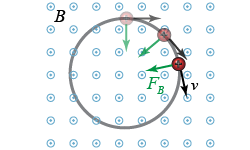 An electromagnet located 10 cm east of a compass deflects the compass needle 45° east. If the Earth’s magnetic field is 5×10−5 T, what is the strength of the electromagnet’s magnetic field at the location of the compass needle? An electromagnet located 10 cm east of a compass deflects the compass needle 45° east. If the Earth’s magnetic field is 5×10−5 T, what is the strength of the electromagnet’s magnetic field at the location of the compass needle?
- Joaquim’s household electric service delivers alternating current at 120 V, but his homebuilt robot requires 30 VAC. The transformer in his power converter has 1,200 turns on the side that receives the 120 V current. How many turns are required on the 30 V side of the transformer?
 A typical installation of power lines on a street, carried by wooden poles, carries the electricity at 12,000 V. A typical installation of power lines on a street, carried by wooden poles, carries the electricity at 12,000 V.
- By what factor must this voltage be changed before running it through a wire to a household?
- Somewhere along the street is a transformer that changes the voltage for household use. Is this a step-up or step-down transformer?
- Assuming the wires entering and exiting this transformer have the same resistance per meter, what is the ratio of the dissipated power per meter for those wires?
 Colin and Suzette have heard that you can generate electricity by spinning an extension cord like a jump rope. Suppose you could spin a circular wire loop once per second in the presence of Earths magnetic field (B = 3×10−5 T near the equator). Colin and Suzette have heard that you can generate electricity by spinning an extension cord like a jump rope. Suppose you could spin a circular wire loop once per second in the presence of Earths magnetic field (B = 3×10−5 T near the equator).
- What would be the maximum magnetic flux ΦB through the loop if the loop had a radius of 1 m?
- If you went from zero flux to this maximum value in a quarter of a second (Δt = 0.25 s), what would be the magnitude of the average induced voltage?

 The generator illustrated here consists of one rectangular wire coil, 20 cm by 60 cm, in a uniform, constant 0.1 T magnetic field. An external force rotates the loop a quarter turn (from θ = 90° to θ = 0°) in 0.0025 s. Which of the following is approximately equal to the average voltage delivered by the generator during this quarter turn? (Ignore the sign, or polarity, of the voltage.) The generator illustrated here consists of one rectangular wire coil, 20 cm by 60 cm, in a uniform, constant 0.1 T magnetic field. An external force rotates the loop a quarter turn (from θ = 90° to θ = 0°) in 0.0025 s. Which of the following is approximately equal to the average voltage delivered by the generator during this quarter turn? (Ignore the sign, or polarity, of the voltage.)
- 5 mV
- 5 V
- 5,000 V
| |  In a physics experiment, a rectangular coil with an area of 1 cm2 is placed in a 0.0001 T magnetic field. In a physics experiment, a rectangular coil with an area of 1 cm2 is placed in a 0.0001 T magnetic field.
- If the plane of the coil is perpendicular to the magnetic field, what is the magnetic flux through the coil?
- If the plane of the coil is parallel to the magnetic field, what is the magnetic flux through the coil?

 When a charged particle moves at right angles to a uniform magnetic field, the magnetic force acts like a centripetal force. That force keeps the particle on a circular “orbit” until the particle loses energy. The circle’s radius is known as the cyclotron radius (see page 562). When a charged particle moves at right angles to a uniform magnetic field, the magnetic force acts like a centripetal force. That force keeps the particle on a circular “orbit” until the particle loses energy. The circle’s radius is known as the cyclotron radius (see page 562).
- Suppose you double the particle charge but leave its speed and mass unchanged. Will this alter the gyroradius? If so, by what factor?
- Suppose you double the particle mass but leave its speed and charge unchanged. Will this alter the gyroradius? If so, by what factor?
- Suppose you double the strength of the magnetic field but leave the speed, mass, and charge of the particle unchanged. Will this alter the gyroradius? If so, by what factor?
 Positively charged protons are the nuclei of hydrogen atoms, and they travel through space after being launched by coronal mass ejections. Some of these protons later collide with the Earth’s magnetic field. Suppose that a proton reached the stratosphere at a speed of 300 km/s and encountered a magnetic field with strength B = 10 nT = 10−8 T. Positively charged protons are the nuclei of hydrogen atoms, and they travel through space after being launched by coronal mass ejections. Some of these protons later collide with the Earth’s magnetic field. Suppose that a proton reached the stratosphere at a speed of 300 km/s and encountered a magnetic field with strength B = 10 nT = 10−8 T.
- If the proton’s motion were parallel to the magnetic field, what magnetic force (in newtons) would it feel?
- If the proton were to move at right angles to the magnetic field, what force would it feel?
- The proton’s mass is mp = 1.67×10−27 kg, and its electrical charge is qp = +1.60×10−19 C. If the proton were to be trapped by the magnetic field, what would its cyclotron radius be? (The cyclotron radius is defined on page 562.)
|

